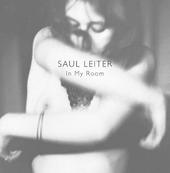
|
Saul Leiter: In My Room
Hardback
Main Details
| Title |
Saul Leiter: In My Room
|
| Authors and Contributors |
By (author) Saul Leiter
|
| Physical Properties |
| Format:Hardback | | Pages:192 | | Dimensions(mm): Height 203,Width 200 |
|
| Category/Genre | Individual photographers |
|---|
| ISBN/Barcode |
9783958291034
|
| Classifications | Dewey:779.092 |
|---|
| Audience | |
|---|
| Illustrations |
85 Halftones, duotone
|
|
Publishing Details |
| Publisher |
Steidl Publishers
|
| Imprint |
Steidl Verlag
|
| Publication Date |
21 June 2018 |
| Publication Country |
Germany
|
Description
Fed by thrilling recent discoveries from Saul Leiter's vast archive, In My Room provides an in-depth study of the nude, through intimate photographs of the women Leiter knew. Showing deeply personal interior spaces, often illuminated by the lush natural light of the artist's studio in New York City's East Village, these black-and-white images reveal the unique collaboration between Leiter and his subjects. In the 1970s, Leiter planned to make a book of his nudes, but never realized the project in his lifetime. Now we are granted a first-time look at this body of work, which Leiter began on his arrival in New York in 1946 and chipped away at over the next two decades. Leiter, who was also a painter, incorporates abstract elements into these photographs and often shows the influence of his favorite artists, including Bonnard, Vuillard and Matisse. The prolific Leiter, who painted and took pictures fervently up to his death, worked in relative obscurity well into his eighties. Leiter preferred solitude in life, and resisted any type of explanation or analysis of his work. With In My Room, Leiter ushers viewers into his private world while retaining his strong sense of mystery.
Author Biography
Saul Leiter was born in 1923 in Pittsburgh. He pioneered a painterly approach to colour photography in the 1940s and produced covers for fashion magazines such as Esquire and Harper's Bazaar before largely withdrawing from public attention in the 1980s. The publication in 2006 of his first collection, Early Color, inspired an avid 'rediscovery' that has since led to worldwide exhibitions and the release of a documentary, In No Great Hurry: 13 Lessons in Life with Saul Leiter (2013). He died in New York in 2013.
ReviewsAs New York's famous mid-century photographers set out to capture the city in shades of black and gray, Saul Leiter rendered its unassuming details in expressive color. Using temperamental expired film, Leiter saw the streets in sharp punches of red and vast seas of shadow. "Seeing is a neglected enterprise," Leiter once said. A painter as well, he captured the impression of a place--figures, snow, fog, concrete, and lamplight--daubed, like brushstrokes.--Jacqui Palumbo "Artsy" Here, in an intimate monograph, Leiter's work is presented for the first time, allowing us a glimpse into his private world...He resisted explaining or analyzing his work, allowing the photographs to speak for themselves. This makes the images something of a Rorschach Test, inviting us to look inside and reflect upon what his work triggers in us.--Sara Rosen "Feature Shoot" It is the clear sense of collaboration between subject and artist that makes these images so striking.--Daisy Woodward "AnOther Magazine" The book is an homage and a love letter.--Vince Aletti "Photograph" The great photographer captured thousands of unguarded moments in his New York studio, finding beauty in surprising places.-- "Guardian" The images are lovingly and expertly reproduced in a broad dynamic range from delicate gray tones to rich blacks, and is beautifully printed on heavy matte paper by master printer Steidl.--Richard Rivera "New York Journal of Books" These quiet, intimate black-and-white photographs, which Leiter developed himself in his darkroom, were kept under lock and key during his lifetime; only a few friends knew them. His female models were friends or lovers whom the artist portrayed in the everyday setting of his New York apartment; they were not professional nude models. As if in an act of conspiracy, they joined the photographer in playful collaboration to challenge the dualistic principle of voyeurism and exhibitionism.-- "Eye of Photography"
|